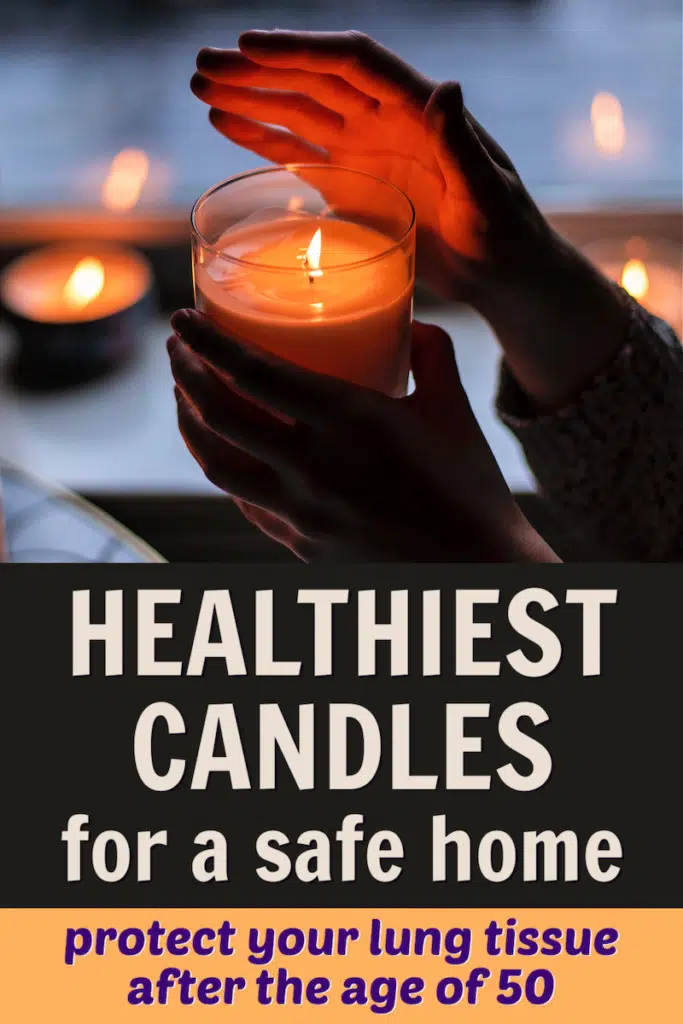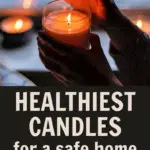Research has established that taking extra steps to protect your lung health is wise. The healthiest candles can help make your home safer. The video lower within this article should prove helpful.
You can enhance the peacefulness of your home – without compromising its safety and indoor air quality – by using the healthiest candles available:
- Some candles are good for your health. They create a serene environment and, therefore, help to reduce your stress.
- Other candles can significantly increase indoor air pollution, effectively poisoning the air.
Does Your Home Environment Enhance Your Health, or Drain It?
While diet and exercise continue to be two of the most important lifestyle habits, it’s essential also to pay close attention to your daily environment – the sounds, the sights, and the smells – because your environment can either enhance or drain your health.
Flickering candles add beauty and create ambiance, while scented candles can set a mood that is uplifting, homey, or even sensual.
But are you sure you’re burning the healthiest candles for your home?
Recent research highlights the concerning state of indoor air quality compared to outdoor air. A pilot study published in the journal Atmosphere in 2021 found that indoor levels of particulate matter (PM 2.5) were significantly higher in homes compared to office environments.
Additionally, Dyson’s first Global Air Quality report, based on data from over 2.5 million air purifiers, revealed that for more than six months of 2020, 85% of the countries studied had worse indoor air quality than outdoor.
Moreover, Dyson’s data from 2022 indicates that in the United States, indoor PM2.5 levels were higher than outdoor levels for nine months of the year.
This data emphasizes the persistent issue of indoor air quality being inferior to outdoor air quality across various regions and seasons.
More specifically, a recent study sheds light on the potential negative impact of burning candles on indoor air quality – depending on the candles used – highlighting potential health risks. And, this Danish cohort study examined the emissions of ultrafine particles from five types of candles, exploring the association between candle use and cardiovascular and respiratory events.
Best Candles for a Healthy Home
Yesterday during lunch with a friend, I mentioned that my spouse and I were doing a detoxification program. He asked how often we do a detox, and I responded, “every 4 to 6 months.”
article by Jim Harris and Dane Findley
My friend looked puzzled and replied, “you live such a clean life. Why would you detox so often?”
My answer was that none of us live in a protective bubble. We are all exposed to toxins regularly – no matter how much we attempt to protect ourselves.
Most of us inadvertently add to our toxic burden daily without knowing where it’s coming from.
“The environment in our home can either enhance our health – or drain it.”
A client mentioned that her yoga studio burns several paraffin wax candles during training sessions, making her feel ill.

Another client who performs maintenance on heating and air conditioning systems says he can easily recognize when a household burns candles because of the black soot deposited on the filters within the furnace or heat exchanger.
“Indoor air pollution levels are typically 2-5 times higher than outdoor pollution levels and can quickly become 100 times worse than outdoor air pollution.”
Nearly everyone loves candles – especially if they smell good – however, are you harming your health with the candles you burn?
It’s little known, but research has established lung condition and size correlates with longevity. In other words, people with the largest and healthiest lungs live the longest. Pulmonary function is a long-term predictor of mortality in the general population.
Are Paraffin Candles the Healthiest?
According to the EPA, paraffin wax candles are a leading cause of indoor air pollution.
Paraffin wax is part of the organic material in the petroleum sludge left over from oil and gas production. The wax is treated, bleached, and processed into a solid and used to make various things, including candles.
“many of us are inadvertently adding to our toxic burden on a daily basis without knowing where it’s coming from”
Most candles on the market today are made from paraffin wax; many have potentially toxic metal wicks and are scented with synthetic fragrances. Stabilizers are often added to the paraffin to control how the candle burns.
Beeswax candles that are free of synthetic fragrances and possess cotton wicks are preferable.
Candles can emit trace amounts of chemicals such as formaldehyde, acetaldehyde, acetone, and naphthalene, which sound very nasty to breathe.
Paraffin candles produce smoke and soot, which are the product of petroleum-based paraffin wax. A 2009 study confirmed that even unscented, non-pigmented paraffin candles using no dyes still released pollutants into the air. While these candles can smell and look good, they may impact your health by adding to your toxic burden.
Keeping Your Home Safe with the Nontoxic, Healthiest Candles
Fortunately, there are alternatives. The healthiest candles include:
- soy and beeswax candles
- candles with wicks made from braided cotton or paper with a cellulose core (the purpose of a “core” in a wick is to prevent the wick from falling over and extinguishing itself)
- candles that contain plant-based all-natural essential oils; essential oils usually won’t trigger asthma and can indeed have a therapeutic effect.
A significant benefit of beeswax is that it allows for complete combustion of the wax and the wick due to the hotter flame resulting from the beeswax.
Beeswax gives a slow, clean burn that is virtually smoke-free and soot-free.
Beeswax candles do not drip. Lighting a beeswax candle burns slowly and evenly with golden bright light and releases a honey fragrance, calming your environment.
Although I don’t always advocate soy as a healthy food, soy candles are clean-burning and a healthier alternative to paraffin candles. Be sure your soy candle is 100% soy (for example, not 10% soy and 90% paraffin). Check out the video:
Enjoy the healthiest candles and remember they have open flames, and precautions must be taken to prevent an unexpected fire in your home:
- Never leave burning candles unattended;
- keep lighted candles away from children and pets;
- keep the wick trimmed for a low flame to minimize soot and emissions;
- use sturdy candle holders;
- ensure good ventilation in the area where candles are burned;
- and always keep candles clear of combustible materials.
More manufacturers make truly pure, safe candles – you just have to look for them – so choose your candles carefully.
A 2-year study of almost 10,000 participants (Lawrence Berkeley National Laboratory) found that people spend about 87% of their day sealed inside homes or buildings. In truth, the human animal was probably not designed to spend that much time indoors; therefore, it’s good to take an objective look around your home to see how air quality can be improved. Switching to the healthiest candles is an easy way to begin that process.
Only choose the healthiest candles to burn inside your home. Your lung tissue will thank you for it.
Additional Resources on Healthy VS Unhealthy Candles:
Scented Candles and Wick Types Matter for Indoor Air – https://iaq.works/indoor-air/the-hidden-truth-about-scented-candles-and-air-quality/
Correlating Healthy Lung Tissue and Wise Lifestyle Habits with a Longer Lifespan – https://www.nih.gov/news-events/nih-research-matters/healthy-habits-can-lengthen-life and https://www.hsph.harvard.edu/nutritionsource/healthy-longevity/
